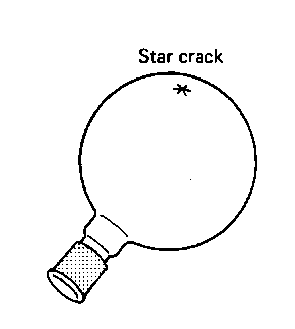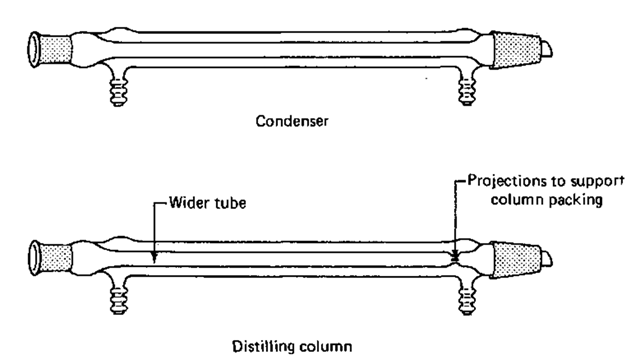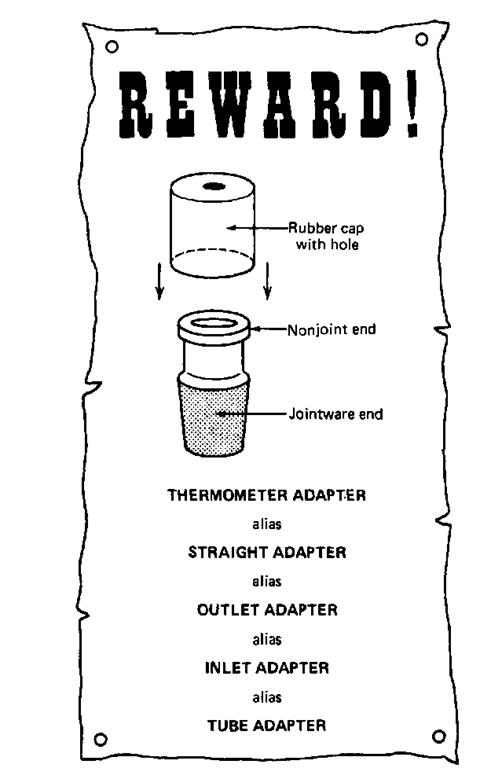By : James W Zubrick
Email: j.zubrick@hvcc.edu
Using standard taper jointware you can connect glassware without rubber stoppers, corks, or tubing. Pieces are joined by glass connections built into the apparatus (Fig. 17). They are manufactured in standard sizes, and you’ll probably use T19/22.
The symbol T means standard taper. The first number is the size of the joint at the widest point, in millimeters. The second number is the length of the joint, in millimeters. This is simple enough. Unfortunately, life is not all that simple, except for the mind that thought up this next devious little trick.
STOPPERS WITH ONLY ONE NUMBER
Sounds crazy, no? But with a very little imagination, and even less thought, grave problems can arise from confusing the two. Look at Fig. 18, which shows all glass stoppers are not alike. Interchanging these two leads to leaking joints through which your graded product can escape. Also, the T19/22 stopper is much more expensive than the T19 stopper, and you may have to pay money to get the correct one when you check out at the end of the course. Please note the emphasis in those last two sentences. I appeal to your better nature and common sense. So, take some time to check these things out.
Fig. 17 Standard taper joints (I 19/22).
As you can see from Fig. 18, that single number is the width of the stopper at its top. There is no mention of the length, and you can see that it is too short. The T19 stopper does not fit theT19/22 joint. Only the T19/22 stopper can fit the T19/22 joint. Single-number stoppers are commonly used with volumetric flasks. Again, they will leak or stick if you put them in a double-number joint.
With these delightful words of warning, we continue the saga of coping with ground-glass jointware. Fig. 19 shows some of the more familiar pieces of jointware you may encounter in your travels. They may not be so familiar to you now, but give it time. After a semester or so, you’ll be good friends, go to reactions together, maybe take in a good synthesis. Real fun stuff!
These pieces of jointware are the more common pieces that I’ve seen used in the laboratory. You may or may not have all the pieces shown in Fig. 19. Nor will they necessarily be called EXACTLY by the names given here. The point is find out what each piece is, and make sure that it is in good condition before you sign your life away for it.
Fig. 18 A119 nonstandard stopper in a II9/22 standard taper joint.
Fig. 19 Some jointware.
ANOTHER EPISODE OF LOVE OF LABORATORY
“And that’s $28.46 you owe us for the separatory funnel.” “But it was broken when I got it!” “Should’ve reported it then.”
“The guy at the next bench said it was only a two-dollar powder funnel and not to worry and the line at the stockroom was long anyway, and . . . and . . . anyway the stem was only cracked a little . . . and it worked O.K. all year long . . . Nobody said anything. …” “Sorry.”
Tales like these are commonplace, and ignorance is no excuse. Don’t rely on expert testimony from the person at the next bench. He may be more confused than you are. And equipment that is “slightly cracked” is much like a person who is “slightly dead.” There is no in-between. If you are told that you must work with damaged equipment because there is no replacement available, you would do well to get it in writing.
HALL OF BLUNDERS AND THINGS NOT QUITE RIGHT
Round-Bottom Flasks
Round-bottom (R.B.) jointware flasks are so round and innocent looking, that you would never suspect they can turn on you in an instant.
1. Star cracks. A little talked about phenomenon that turns an ordinary R.B. flask into a potentially explosive monster. Stress, whether prolonged heating in one spot, or indiscriminate trouncing upon hard surfaces, can cause a flask to develop a star crack (Fig. 20) on its backside. Sometimes they are hard to see, but if overlooked, the flask can split asunder at the next lab.
2. Heating a flask. Since they are cold-blooded creatures, flasks show more of their unusual behavior while being heated. The behavior is usually unpleasant if certain precautions are not taken. In addition to star cracks, various states of disrepair can occur, leaving you with a benchtop to clean. Both humane and cruel heat treatment of flasks will be covered in (see Chapter 13, “Sources of Heat”), which is on the SPCG (Society for the Prevention of Cruelty to Glassware) recommended readings list.
Fig. 20 R.B. flask with star crack.
Columns and Condensers
A word about distilling columns and condensers:
Different!
Use the condenser as is for distillation and reflux (see Chapter 15, “Distillation,” and Chapter 16, “Reflux”). You can use the column with or without column packing (bits of metal or glass or ceramic or stainless-steel sponge — whatever)! That’s why the column is wider and it has projections at the end (Fig. 21). These projections help hold up the column packing if you use any packing at all (see Fig. 80).
If you jam column packing into the skinny condenser, the packing may never come out again! Using a condenser for a packed column is bad form and can lower your esteem or grade, whichever comes first.
You might use the column as a condenser. Never use the condenser as a packed column!
The Adapter with Lots of Names
Fig. 22 shows the one place where joint and non joint apparatus meet. There are two parts: a rubber cap with a hole in it and a glass body. Think of the rubber cap as a rubber stopper through which you can insert thermometers, inlet adapters, drying tubes, and so on.
Fig. 21 Distilling column versus condenser.
Fig. 22 Thermometer adapter.
CAUTION!
Do not force. You might snap the part you’re trying to insert. Handle both pieces through a cloth; lubricate (water) and then insert carefully.
The rubber cap fits over the nonjoint end of the glass body. The other end is a ground glass joint and fits only other glass joints. The rubber cap should neither crumble in your hands nor need a 10-ton press to bend it. If the cap is shot, get a new one. Let’s have none of these corks, rubber stoppers, chewing gum, or any other type of plain vanilla adapter you may have hiding in the drawer.
And remember: Not only thermometers, but anything that resembles a glass tube can fit in here! This includes unlikely items such as drying tubes (they have an outlet tube) and even a funnel stem (you may have to couple the stem to a smaller glass tube if the stem is too fat). The imaginative arrangements shown in Fig. 23 are acceptable.
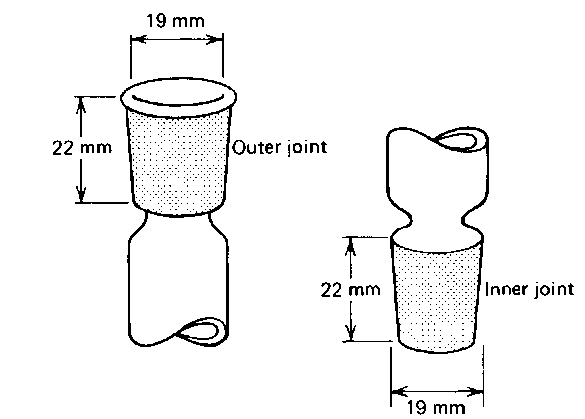
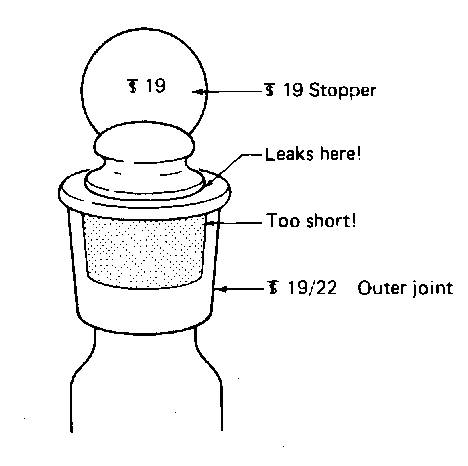
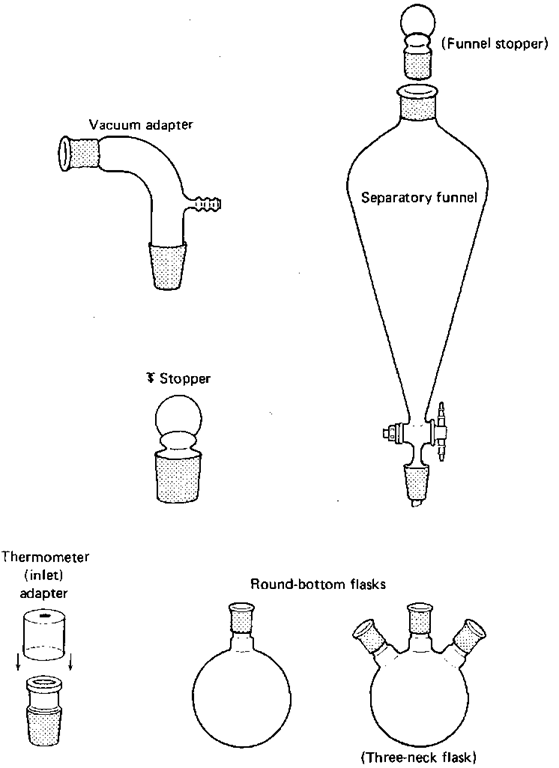
![tmp30-100_thumb[1] tmp30-100_thumb[1]](http://what-when-how.com/wp-content/uploads/2011/06/tmp30100_thumb1_thumb.png)
